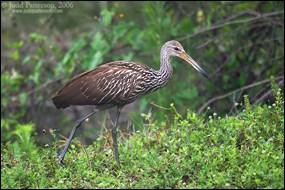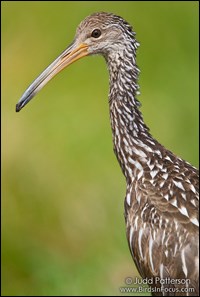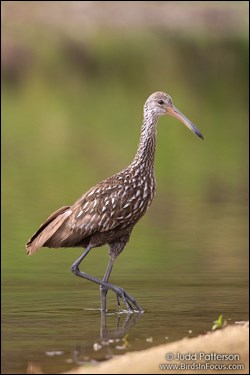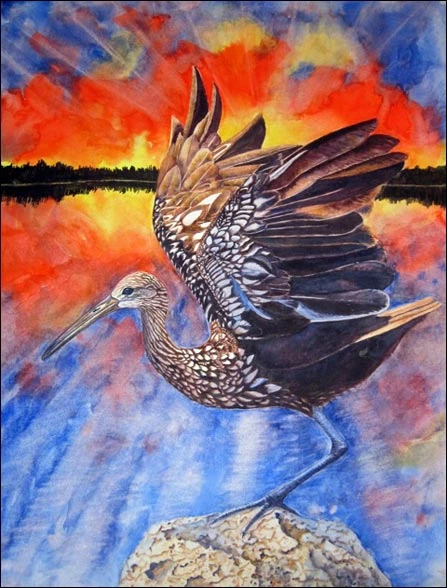
Photo courtesy of Judd Patterson, www.juddpatterson.com Limpkins (Aramus guarauna) are more commonly heard than seen. Most often heard at dawn, dusk, and during the night, limpkins typically vocalize with a loud and rattling wail or scream. However, in places where they do not fear people, such as in parks and wildlife refuges, limpkins may be active during the day, although they don't typically stray far from cover. The limpkin is the only member of its taxonomic family, Aramidae. Although they resemble herons and ibises in general form, limpkins are generally considered to be more closely related to rails and cranes. Brown with white spots and streaks, limpkins have long necks, bills, and legs. Immature limpkins are similar in appearance to adults but have fewer white markings. 
Photo courtesy of Judd Patterson, www.juddpatterson.com In Florida, limpkins feed almost exclusively on apple snails. A limpkin uses its long, uniquely adapted bill to extract the apple snail from its shell. When closed, the bill has a gap just before the tip that makes the bill act like a pair of tweezers. Because the tip of the bill is typically curved slightly to the right, the bill can slip easily into the right-handed chamber of an apple snail shell. The availability of apple snails affects the distribution of limpkins. Although limpkins prefer a diet of apple snails, their secondary food sources include freshwater mussels and other kinds of snails. During times when apple snails are in scarce supply, such as during periods of drought or flooding, limpkins may also eat insects, frogs, lizards, crustaceans, and worms. 
Photo courtesy of Judd Patterson, www.juddpatterson.com Limpkins forage primarily in shallow water.They walk slowly with a slightly undulating and high-stepping gait that can make them appear to be lame or limping, hence their name. They forage in small groups with other limpkins and do not associate with other species of wading birds. Limpkins reach the northern limit of their breeding range in Florida, where they inhabit swamps and marshes. From Florida, their range extends south through southern Mexico, the Caribbean, and Central and South America. Limpkins nest in a variety of habitats, from on top of the surface of floating vegetation to tree limbs high above the ground. They gather sticks, vines, leaves, moss, grass, and other types of vegetation, which they use to construct shallow nests. 
Original artwork courtesy of Kathleen Konicek-Moran, NPS volunteer About the Illustrations The vibrant, detailed nature illustrations on this page and others are by NPS volunteer and artist Kathleen Konicek-Moran. Kathleen has graciously allowed Everglades National Park to use her original works to help convey the vital connections inherent within the Everglades ecosystem. Learn more about Kathleen Konicek-Moran and what inspires her bountiful flow of creativity. |
Last updated: October 17, 2017
